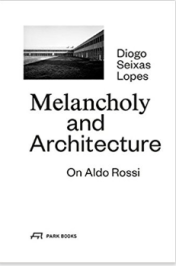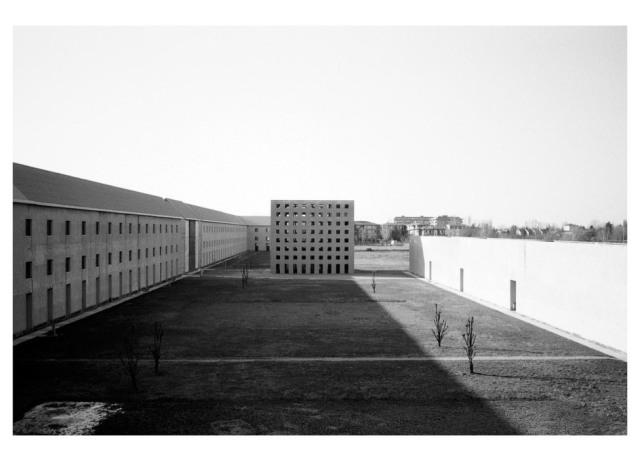
Melancholy and Architecture: On Aldo Rossi, by Diogo Seixas Lopes, Park Books
Review by Herbert Wright
(originally published in Blueprint magazine July 2015)
They look rather like scenes painted by de Chirico, but they are not. One is an engraving of isolated objects casting shadows, including coffee pots and chimneys, but the composition is more densely stuffed than those of the great Italian surrealist, and buildings lean and fracture. The other is a view that is solidly imprinted in the collective architectural mind, of a timeless brick cube, each face punched with a grid of dark squares. It is an ossuary in Modena, Italy. Both are the works of the great Italian architect and theorist, Aldo Rossi.

The 1975 engraving, Dieses ist lange her / Ora questo è perduto (This is long gone) is reproduced at the beginning of Diogo Seixas Lopes’ book Melancholy and Architecture, which probes the relation between the two by examining Rossi’s San Cataldo cemetery in Modena, designed in 1971. The cemetery has been widely compared to the metaphysical landscapes with outcrops of classical buildings from de Chirico, and Rossi himself acknowledged his influence. It is also seen as embodying an essence of Rossi’s seminal book L’architettura della città (1966) and its central idea that the city carries a collective memory in its architecture and resulting artefacts, as if the cemetery’s plan and monumental elements was a demonstration of this premise. San Cataldo’s veritably iconic ossuary cube is instantly recognisable to people who have never been there.
We are taken out on two great trails before we arrive at San Cataldo — first, the history of what we understand as melancholy, from its early associations with black bile, through the Renaissance’s attribution to it of intellect and uncertainty, and via the new urban alienation of the 19th Century to the psychoanalytical view of it by Freud as similar to mourning. An architectural dimension is established with Piranesi’s ruins, the visionary monumentalism of Etienne- Louis Boullée (exalted and translated by Rossi) and Adolf Loos’ contention that architecture arouses moods.
The second trail charts the background and development of Rossi’s thought. He was interested in architecture’s emotional effect, but when the gritty Italian ‘neorealism’ of post-war literature and cinema was applied to architecture, Rossi dismissed it as a superficial veneer. He developed a deeper historic- urbanistic view, encapsulated in the 1966 book. In 1971, Modena held a competition for a vast cemetery extension, which Rossi would enter with Gianni Braghieri. Soon after, Rossi was in a car crash in Croatia. In his hospital bed, he ‘experienced a relation with death that never went away’, he would write, calling it ‘probably the only impossible love’. His body broken like elements in the engraving, he developed his vision for the city of the dead at San Cataldo.

San Cataldo cemetery, Modena. Photo by Nuno Cera
The book includes the original monumental plan and elevations, with their unbuilt rising rows originally intended for the ossuary function and a truncated cone for the communal dead. There’s no photo of the architectural model, but the plans’ draughtsmanship makes stark the three-dimensional aspect by drafting in shadows (which were coincidentally crucial tools for de Chirico). There is also a brief photographic survey of the cemetery elements that were eventually built.
Seixas Lopes, as co-designer of the remodelled Teatro Thalia in Lisbon (Blueprint November 2012), is well qualified to talk about architecture and memory. There’s a potentially dubious conflation of ideas in mapping Rossi’s idea of the city carrying collective memory on to a city of the dead, functioning to house their memory in physical bones and mourners’ minds. Aren’t they different things? But Seixas Lopes deftly binds San Cataldo to Rossi’s ideas of city and architecture together in a dense, thorough and absorbing critical analysis. Rafael Moneo did the same in a 1973 essay, but this is no retread. From Seixas Lopes’ pleasing dismissal of similarities between the ossuary and the fascist-era Palace of Italian Civilisation in Rome’s EUR quarter, to examining Rossi’s contemporaneous housing block at Gallaratese (which has an echo in San Cataldo’s perimeter block), the book lays out a new map. It is coloured with rationalism… and melancholy.
Unlike Moneo, Seixas Lopes has the benefit of looking over Rossi’s subsequent work, when he became something of a proto-starchitect. Commissions proliferated and he received the 1990 Pritzker. He was slapped with the label postmodernist. (Curiously, the book gives Italy’s architectural movement La Tendenza, which presaged postmodernism and to which Rossi was pivotal, just a fleeting paragraph).
It would have been good to see a picture of Rossi’s big, fantastic floating Theatre of the World deployed in Venice in 1980, which Seixas Lopes describes, but instead we get an unexplained picture of a small structure steered by two gondoliers. It may have been interesting to ask if Rossi’s colourful Schützenstrasse block (1998) in Berlin was a counterpoint to his melancholy. And an index sure would have been handy. But these are passing criticisms.
As a study of melancholy and architecture that researches and probes deep into its chosen case studies of San Cataldo and Rossi’s mind, the book is illuminating and substantial. It seems set to become indispensable.
____________________
This book review was originally published in Blueprint magazine no341, July 2015. This version is edited. A tribute to the book’s late author Diogo Seixas Lopes is here.
